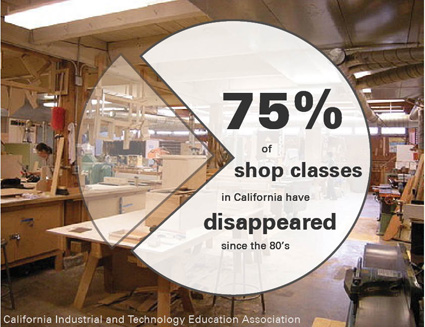Future Now
The IFTF Blog
Shop Class, Makers, and The Future of Education in California
Imagine taking a class in high school where you can create a tool for eating your favorite food. Maybe you want a special set of chopsticks to eat your homegrown salad, or a high-tech polymer spork to scoop up the latest in laboratory grown nutrients. What you decide to build is limited only by the imagination. And if this is your first time deigning and manufacturing something, do not fear, an experienced maker will be there to guide you through the process.
As an intern at IFTF, I had the opportunity to conceptualize an activity and share it with the world. This concept is Inspired by Dave Eggers' TED Wish, where he asks for stronger participation between schools and the community. Through a tutoring class, Eggers discovered that if students have the opportunity to make something real, with help from adults, they will “work harder than they ever have in their lives… and once they reach that level they will never go back.” After seeing the power of this collaboration, I decided to ask, “What could happen if the Maker community collaborates with K-12 education in California?”

A student/maker collaboration has great potential. While the Maker community is flourishing, the education system has seen better days. An estimated 50% of kids never graduate from high school [source]. Studies have suggested that students are more likely to stay in school and get better grades if they can apply knowledge to real world activities. Shop class is a great place for students to do this, but 75% of all California shop classes have been cut since the 1980's due to budget cuts.
This is where the student/maker collaboration comes in. Makers could volunteer to teach young people what they know about design and manufacturing, and help connect students to real world opportunities. Maker spaces such as Tech Shop could provide creative environment and equipment for construction, providing students with an engaging learning experience without digging too deep into the state's education budget.
The activity could go something like this: First the students learn about the history of eating utensils to get a better understanding of context. Then, with help from a maker, students design and manufacture their eating utensil. Sharing what you build and how it is built is a strong part of the maker community. This can be done through existing sites like Instructables, or perhaps a public art gallery. And finally we will need to celebrate both the eating utensils and creative powers with a feast.
Building an eating utensil will empower students with both creative and critical thinking skills. And working along side professional makers will help build relationships with people working outside of the school walls. With these skills and connections, graduating students will be better prepared to make their way in the world.
With proper support from both education and the maker community, this activity could be implemented in California public schools. Special thanks to Anna, Ben, David, Jason, Jean and the IFTF intern team for helping put this concept together.



